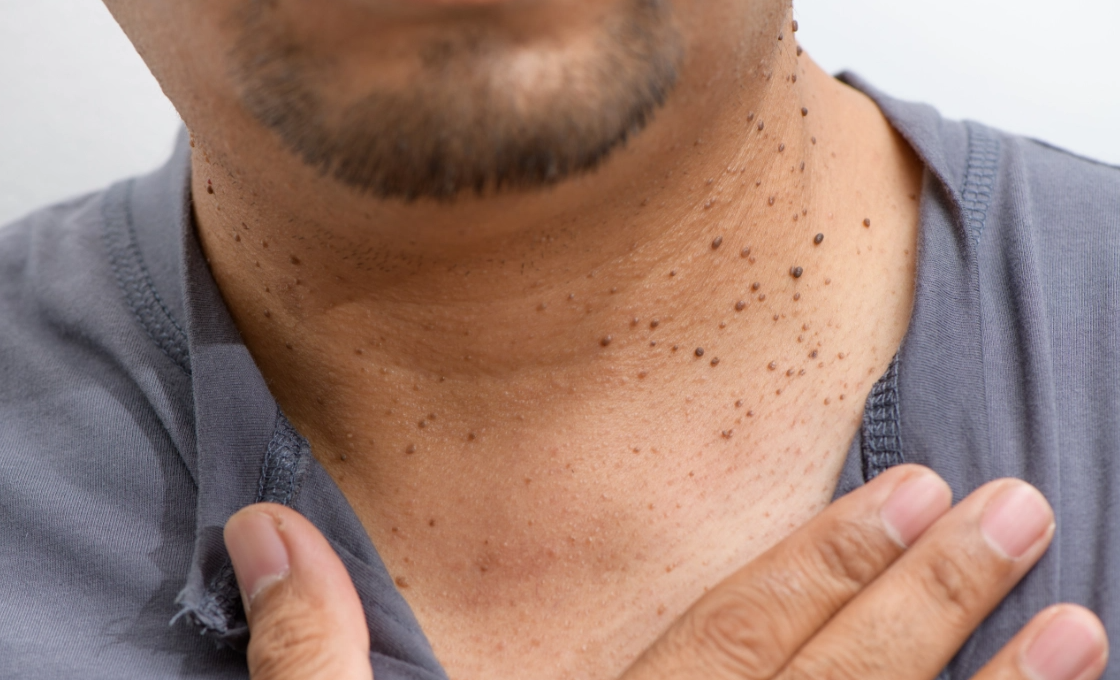

Skin Tags
What are skin tags?
Skin tags are noncancerous growths that develop on the folds of your skin. They look like a flap of skin tissue that hangs from a tiny stem connected to the skin. Skin tags are usually the same color as the rest of your skin, but they can also appear slightly darker in color. The medical term for skin tags is acrochordons.
Skin tags are generally small, about the size of a pebble, but they can grow larger. Most skin tags aren’t painful, although they can cause irritation if they rub against jewelry or clothing. Most of the time, skin tags do not require treatment, but they can be removed if they are bothersome.
Are skin tags common?
Skin tags are very common. It’s estimated that almost 50% of adults develop at least one skin tag in their lifetime.
REQUEST NOWWhat causes skin tags, and where can skin tags occur on your body?
The specific cause of skin tags is unknown, but one possibility is that they form as a result of skin irritation caused by friction – either from rubbing within folds of the skin or against clothing. They can also form when extra cells are produced in the top layers of skin.
Skin tags can occur anywhere on your body, but they are more likely to form in skin folds or parts of the body where the skin rubs against itself. Skin tags often develop on these parts of the body:
- Neck
- Armpits
- Eyelids
- Inner thighs
- Under the breasts
- Groin

What are the risk factors for skin tags?
Although anyone can develop skin tags, the chances of developing skin tags increase with age. They’re also more common in people who are overweight or those with diabetes. Hormonal changes, such as those that occur during pregnancy, can also increase your risk of skin tags. If you have a family history of skin tags, you are also more likely to develop them.
How do you treat skin tags?
Skin tags are harmless, and most don’t need treatment. Some skin tags may even fall off on their own. If you’re bothered by their appearance or if they cause discomfort from rubbing against clothing or getting caught in jewelry, your dermatologist can remove skin tags. Your board-certified Forefront dermatologist can remove a bothersome skin tag using any of these skin tag removal procedures:
- Freezing the skin tag with liquid nitrogen, a procedure called cryotherapy
- Using cauterization to burn the skin tag off
- Surgically removing larger skin tags
- Cutting the skin tag off with surgical scissors or another sharp instrument
- Tying a piece of string or dental floss around the skin tag to cut off the blood supply, which causes it to fall off
Your Forefront dermatologist will provide you with specific skin tag removal aftercare instructions. These instructions will vary depending on the treatment you received. In general, you’ll want to keep the area clean, moist, and covered. To prevent the area from becoming dry, you can apply a thin layer of petroleum jelly and cover it with a non-stick bandage.
Should you remove skin tags?
You should never remove skin tags on your own. Over-the-counter products and home remedies to remove skin tags aren’t safe and can increase your risk of complications, such as scarring, bleeding, infection, and damage to the surrounding skin. It’s much safer to have skin tags removed by a dermatologist who has the training and skills needed to minimize scarring.
Do skin tags grow back?
Skin tags usually don’t grow back after removal. However, it’s possible to develop new skin tags on other areas of your body. If a new skin tag forms on the same part of the body after removal, you’re likely prone to developing them in that specific area.
What other skin conditions look like skin tags?
If you have skin tags, it’s important to receive a diagnosis from a board-certified dermatologist. Sometimes, what looks like skin tags may be another condition, such as warts, moles, seborrheic keratosis, and even skin cancer. Skin tags are diagnosed after a visual exam and evaluation. An examination also helps rule out other skin conditions that look like skin tags but may cause more damage if left untreated.
Can you prevent skin tags?
Although you can’t prevent skin tags, you can reduce your risk of developing them by following a few simple steps. Reducing skin friction, such as not wearing tight clothing or jewelry that rubs against the skin, may help keep new skin tags from forming. You can also exercise regularly and eat a healthy diet to reduce your risk of developing diabetes or obesity, two factors linked to the development of skin tags.
Skin tag treatment at Forefront Dermatology
If you’re concerned about skin tags, visit an experienced, board-certified dermatologist at Forefront Dermatology to receive a diagnosis and learn more about skin tag dermatologist treatment options. Schedule your appointment today.
Interested in Skin Tags? Request a consultation with a skin specialist today.
*Treatment options may vary at each location.Please confirm your desired treatment is offered at your preferred location when scheduling. *Age Restriction.
For patients scheduling who are under 18 years of age (19 in Alabama) please make sure you have permission from your parent or legal guardian to schedule this appointment. Your parent or legal guardian must accompany you on your initial visit and on certain subsequent visits to provide appropriate informed consent.